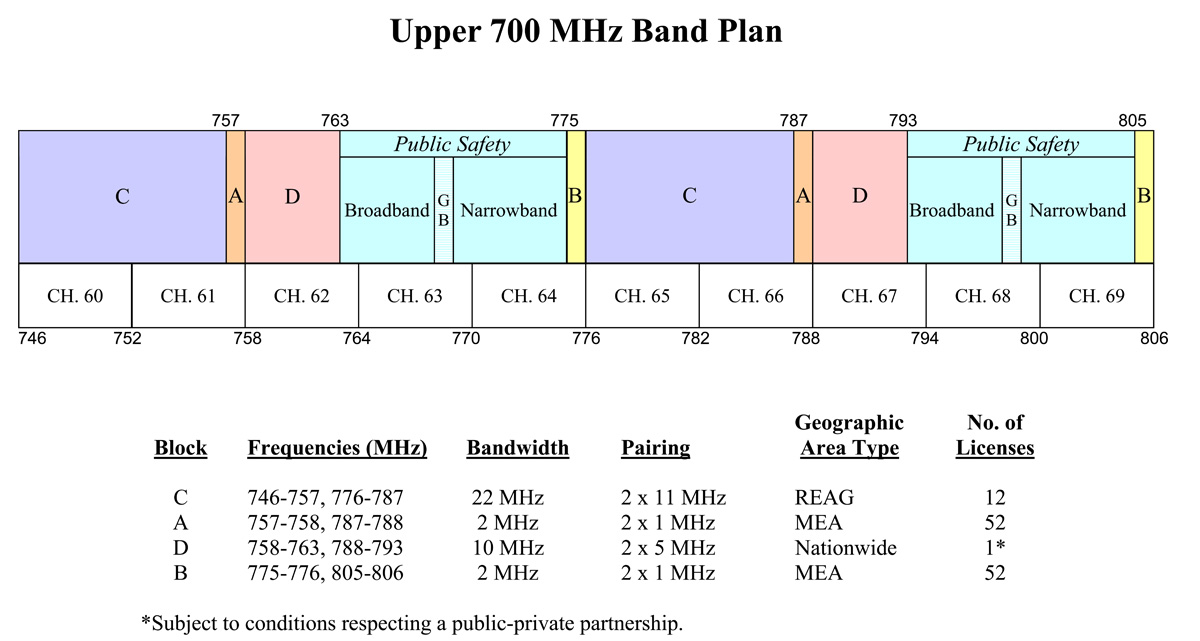| |
|
Upper 700 MHz D Block
|
A brief background on the D block, courtesy of FCC's document DA 12-1462 (Sep 7, 2012):
The D Block and the existing public safety broadband spectrum are part of the Upper 700 MHz Band (746-806 MHz), which was made available for wireless services as a result of the digital television transition (DTV transition). Pursuant to the Balanced Budget Act of 1997, the Commission designated twenty-four megahertz of Upper 700 MHz spectrum for public safety services and the remaining thirty-six megahertz for commercial services to be assigned through competitive bidding. The public safety segment included two six-megahertz narrowband segments (764-767 MHz/794-797 MHz and 773-776 MHz/803-806 MHz) that abutted a twelve megahertz wideband segment (767-773 MHz/797-803 MHz) on either side.
In the Second Report and Order, the Commission reconfigured the public safety segment of the Upper 700 MHz Band to eliminate the wideband segment, consolidate narrowband channels within a single band segment (769-775 MHz/799-805 MHz) at the upper end of the public safety spectrum, and establish at the lower end a ten megahertz broadband segment (763-768 MHz/793-798 MHz). Between the broadband and narrowband segments the Commission placed a two megahertz internal guard band (768-769 MHz/798-799 MHz). The Commission also reconfigured the commercial segment of the Upper 700 MHz band, in part by establishing a ten megahertz commercial "D Block" of spectrum directly adjacent to the public safety broadband spectrum (758-763 MHz/788-793 MHz).
These revisions to the Upper 700 MHz band plan were made to facilitate a public-private partnership for the development of a nationwide interoperable public safety broadband network in the 700 MHz band. The Commission established rules creating a single nationwide license for the public safety broadband spectrum to be granted to a Public Safety Broadband Licensee (PSBL). The D Block was then designated for auction under the condition that its licensee enter into a Network Sharing Agreement (NSA) with the PSBL to construct and operate a nationwide, interoperable broadband network across both the D Block and the 700 MHz public safety broadband spectrum.
In order to effectuate this plan, the Commission established requirements concerning the nature of the shared wireless broadband network and the respective rights and obligations of the D Block licensee and the PSBL regarding their partnership and the network. The Commission adopted rules requiring the parties to execute the NSA prior to the award of the D Block license. In addition, the Commission placed certain other conditions on the D Block license "to protect services to the public safety community and facilitate the success of the 700 MHz Public/Private Partnership, including requirements relating to the organization and structure of the partnership, reporting requirements, and a prohibition on the discontinuance of public safety operations." The Commission also put in place "a means for public safety entities to: (1) obtain an earlier build-out of broadband networks than provided for in the NSA; (2) build their own broadband networks in areas not included in the NSA; and (3) conduct wideband operations via a limited and conditioned waiver process."
Soon after the release of the Second Report and Order, the Commission selected the Public Safety Spectrum Trust (PSST) to serve as PSBL. However, an auction of the D Block in early 2008 under the terms and conditions established in the Second Report and Order failed to produce a winning bid. Later in 2008 the Commission issued a Second and Third Further Notice of Proposed Rulemaking that re-examined various options for achieving an interoperable nationwide public safety network. The D Block was never re-auctioned and remains unlicensed.
In January 2011, the Commission adopted a Third Report and Order, which codified the use of LTE technology for the public safety broadband spectrum and stayed certain Part 90 rules that were designed to implement the mandatory public-private partnership that never came to fruition. An accompanying Fourth Further Notice of Proposed Rulemaking considered further technical rules for ensuring the operability and interoperability of the nationwide public safety broadband network.
In February 2012, the Public Safety Spectrum Act became law. It prescribes a detailed plan for the development of this long-awaited network, and fundamentally altered the regulatory landscape for the 700 MHz band by providing a Congressionally developed long-term vision for using this spectrum to deploy a nationwide public safety broadband network. Among its other provisions, the Act establishes FirstNet as an independent authority within the National Telecommunications and Information Administration (NTIA), and requires the Commission to grant a license to FirstNet for the use of both the existing public safety broadband spectrum and the spectrally adjacent D Block, which the Commission must reallocate for public safety use. The Act charges FirstNet with the responsibility for establishing and overseeing "a nationwide, interoperable public safety broadband network," by taking "all actions necessary to ensure the building, deployment, and operation of the . . . network, in consultation with Federal, State, tribal, and local public safety entities, the Director of NIST, the Commission, and the public safety advisory committee [that section 6205 of the Act requires FirstNet to establish]." Among its more specific duties, FirstNet is responsible for issuing Requests for Proposals (RFPs) and entering contracts for the construction, operation and management of the network on a nationwide basis, using funds allocated for these purposes under the Act.
On August 20, 2012, NTIA announced the appointment of the twelve non-Federal members to the Board of Directors of FirstNet. FirstNet’s Board is thus fully constituted.
|
Paired Frequency Bands |
| Paired Bands | Use | Service | Table |
| 758 - 763 MHz | Upper 700 MHz D Block | Mobile | - |
| 788 - 793 MHz | Upper 700 MHz D Block | Mobile | - |
Associated Files:

Upper 700 MHz band plan (U.S. FCC)
|
|
|
|
|